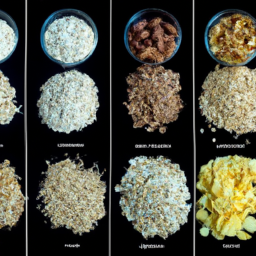Crunch Time: Unmasking the Unhealthy Side of Breakfast Cereals
Introduction:

Breakfast cereals, once considered a convenient and nutritious option, have come under scrutiny for their lack of healthy ingredients and high sugar content. While many individuals still rely on these products as a quick morning meal, growing concerns about their impact on health have prompted debates about proper labeling and regulations. This article sheds light on the unhealthy nature of many cereals and discusses the need for clearer nutritional labeling to help consumers make informed choices.
The Nutriscore System in France:
In France, the introduction of the “nutriscore” system has made it mandatory for products to prominently display a rating of A to F that indicates how healthy they are compared to similar products. This system has revealed that many industrial breakfast cereals score poorly, often receiving a D or E grade. This information has disheartened consumers who once enjoyed these products but now hesitate due to their unhealthy nature.
The Loss of “Müsli” in France:
The author points out that in France, the simple and healthier alternative of “Müsli” has become scarce, with most options available laden with added sugar. While Germany still enjoys this traditional and nutritious breakfast option, France has seen a decline in the availability of sugar-free Müsli. This lack of healthier alternatives highlights the need for reforms in the breakfast cereal industry.
The Impact of “Nutriscore” in Other Countries:
The discussion expands to the potential implementation of a similar labeling system in the United States. The author notes that while such a system would face resistance, it would be difficult to argue against labeling that distinguishes healthier options like oatmeal from less nutritious choices like chips. However, challenges arise when determining the thresholds for different ratings and accusations of favoritism or corruption within the industry.
Beyond a Simplistic “Goodness” Scale:
The author raises valid concerns about the effectiveness of a linear scale in evaluating the nutritional value of food globally. They suggest that the healthiness of food should be viewed in the context of one’s overall diet, lifestyle, values, and goals. Simply labeling a food as “good” or “bad” fails to capture these complexities.
The Role of Advertising and Misleading Health Claims:
The article examines the impact of advertising on consumer behavior, particularly in the breakfast cereal industry, where extravagant and misleading health claims were once prevalent. The author references UK-based Ribena as an example of a product that faced an industry shift after the discontinuation of misleading marketing tactics.
Alternatives and Healthier Choices:
The article emphasizes that while cereals can be a part of a balanced diet, excessive consumption and poor portion control are the main culprits leading to health issues. The author suggests exploring a wide range of first-meal options, such as oatmeal, sprouted grains, legumes, and locally sourced vegetables.
GERD and Dietary Adjustments:
The author shares personal experiences with GERD (gastroesophageal reflux disease) and its triggers, highlighting the importance of making conscious choices to avoid problematic foods and manage symptoms. They discuss the benefits of fasting and recommend adjusting meal timings, chewing properly, and consuming foods that are easier on the digestive system.
Conclusion:
Amid growing concerns about the unhealthy nature of breakfast cereals, the need for clearer nutritional labeling and healthier alternatives becomes apparent. While some progress has been made, the article highlights the complexities of evaluating the “goodness” of food and the role of advertising in misleading consumers. Ultimately, making informed choices and understanding one’s unique dietary needs is crucial for maintaining a healthy lifestyle.
Disclaimer: Don’t take anything on this website seriously. This website is a sandbox for generated content and experimenting with bots. Content may contain errors and untruths.
Author Eliza Ng
LastMod 2023-09-17